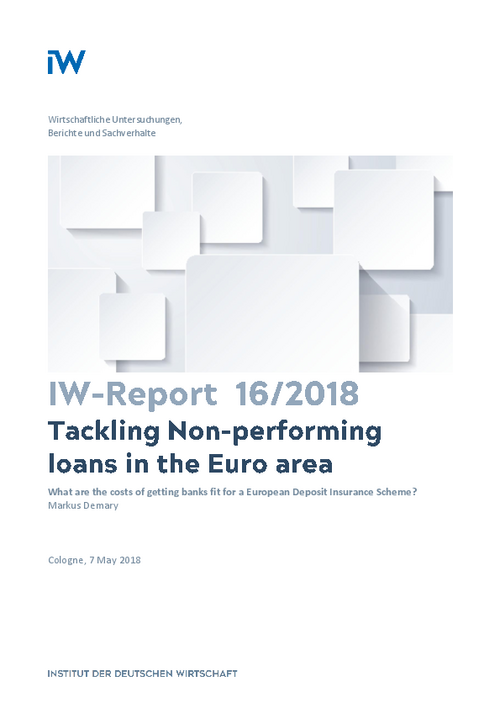The study of non-performing loans (NPLs) is highly relevant when looking for a solution to the ongoing structural weaknesses in the Euro area banking sectors, especially in light of the planned completion of the banking union and the introduction of a European Deposit Insurance System (EDIS).

Tackling Non-performing loans in the Euro area
IW-Report

The study of non-performing loans (NPLs) is highly relevant when looking for a solution to the ongoing structural weaknesses in the Euro area banking sectors, especially in light of the planned completion of the banking union and the introduction of a European Deposit Insurance System (EDIS).
While the aggregate data on non-performing loans shows some improvements, it cannot be ruled out that problems within large and systemically important banks may persist. For the quantification of these risks, the analysis of NPLs must be based on individual bank data. In order to gain a greater insight, I therefore built a dataset of 76 large and systemically relevant banks in the Euro area, which cover 74.6 percent of the non-performing loans in the Euro area. Although data points had to be imputed with the help of other data sources, the dataset provides a helpful impression of the ongoing problems with NPLs.
The analysis reveals that banks with an NPL ratio of 25 percent or higher represent 10.5 percent of the systemically important banks studied here. Moreover, close to 20 percent of the outstanding amounts of the NPLs concentrates on banks with an NPL ratio of 25 percent or higher. When it comes to the dynamics of the NPLs, the decline in the aggregate NPL ratio of the Euro area was mainly driven by banks with moderate NPL ratios that reduced their NPLs further, while banks with higher NPL ratios contributed negatively to the aggregate NPL ratio.
In order to demonstrate the extent to which NPLs can be reduced, I ran several simulations with the dataset. A reduction of NPLs in the amount of the loan-loss provisions of the banks is simulated first. It can be seen that the share of banks with an NPL ratio of only up to three percent could increase from 31.6 percent to 53.9 percent. However, the divide in the banking sector also shows up when it comes to write-offs: banks with a low NPL ratio can easily reduce it even further, while banks with a high NPL ratio have a hard time in reducing it significantly. The problem becomes even more severe at the long end of the NPL distribution. Although the number of banks with an NPL ratio of more than 25 percent can be reduced from 10.5 percent to 3.9 percent, there still remains two large with an NPL ratio of more than 25 percent.
I also simulated an additional write-off together with recapitalisation measures with the aim of finding banks with NPL ratios of 3 percent or lower and equity capital ratios of at least 7 percent. The recapitalisation costs of the banks in Cyprus would then amount to 2.4 percent of the GDP for each year from 2019 to 2022, while the yearly recapitalisation of the Greek banks would amount to 2.0 percent of the Greek GDP. In Italy, yearly recapitalisation measures would amount to 0.8 percent of the Italian GDP. Less exposed would be Spain with yearly recapitalisation costs of 0.4 percent of the GDP.
I conclude from these results, that there are still significant risks in the national banking sectors of the Eurozone, which implies the danger of rendering a common Euro area Deposit Insurance System into a transfer mechanism. If neither the governments nor the private sectors were willing to bear the costs of reducing NPLs and recapitalising their banks, it would be better to abandon the idea of a common deposit insurance or to postpone it far into the future in the hope that banks will grow out of their NPL problems.

Markus Demary: Tackling Non-performing loans in the Euro area – What are the costs of getting banks fit for a European Deposit Insurance Scheme?
IW-Report

More on the topic

IW Financial Expert Survey: First Quarter 2018
The IW Financial Expert Survey for the first quarter of 2018 revealed that the surveyed experts predict, on average, higher interest rates and stock market indices, a depreciation of the Euro vis-à-vis the US Dollar, and lower oil prices by the end of the ...
IW
The Impact of Demographics on the German Retail Market
In recent years, net migration reached a new peak in Germany. Between 2011 and 2015, net migration amounted to more than 2.7 million people. This influx of people has had an impact on society, on the economy in general, and on most businesses.
IW